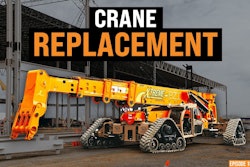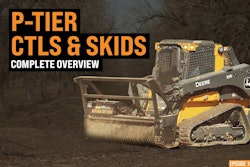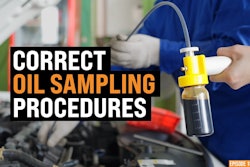Depending on what part of the country you live in, you might not see many track loaders on jobsites.
But after watching this episode of The Dirt, you might ask yourself why that’s the case. Sam Meeker, Caterpillar track loaders specialist, gives a fascinating overview of what he calls “a great big skid steer.”
Cat offers three models of track loaders: the 853, 963 and 973. Meeker details the differences in the models, their many advantages and gives us a brief history of the track loader.
From landclearing to finish grading, the track loader is a real “jack of all trades,” Meeker says. It can load, doze, cut and grade – even single-handedly dig a basement – and save you from having to bring more than one machine to a jobsite.
“There’s a reason this is one of my favorite machines in the industry,” says Bryan Furnace, host of The Dirt and professional operator.
So to find out more about the often-overlooked track loader, check out the latest episode of The Dirt.
Equipment World serves up weekly videos on the latest in construction equipment, work trucks and pickup trucks – everything contractors need to get their work done. Subscribe and visit us at equipmentworld.com!
In This Episode:
- 00:00 – Bryan’s Favorite Type of Machine: Track Loaders
- 00:25 – Cat Track Loader Lineup
- 01:54 – History of the Track Loader
- 03:38 – Advantages of Track Loaders
- 04:13 – Ground Pressure
- 05:20 – Ground Clearing Capabilities
- 06:51 – Basement Digging
- 09:49 – Undercarriage Costs
- 13:24 – More Track Loader Advantages
- 14:45 – Track Loader Applications
- 16:12 – Final Thoughts
00:00:00:10 - 00:00:24:11
Bryan Furnace
Today we're here to talk about one of my absolute favorite machines in the industry. We're here to talk about track loaders. Joining us from Caterpillar today is Sam Meeker. And he's going to give us a rundown of Caterpillar's lineup.
00:00:24:13 - 00:00:34:18
Bryan Furnace
For those of our audience that aren't familiar with Caterpillar's track loader lineup, can you give us an overview of what models you offer and kind of what differentiate us?
00:00:34:19 - 00:00:58:12
Sam Meeker
Yeah. You bet. So the track loader lineup today consists of that 953, that 963 and 973. So if we're taking a look at the models and size classes, you know, you're looking at 160 horse, 200 horse and 275. Or if you want to look at weights, you know, you're in 45,000, 55,000 pounds and 70,000 pounds roughly in those weights.
00:00:58:14 - 00:01:07:12
Bryan Furnace
Okay. And then what kind of yardages are you getting out of those buckets on those machines? Because that's one of the big advantages of track loaders, is they just move a monstrous amount of dirt.
00:01:07:14 - 00:01:27:02
Sam Meeker
Yeah, absolutely. So, you know, on that smaller one, that 953 you're anywhere in that two, two and a half, you know, up to two and three quarter yard. When you get into that 63, now you're in that three, three and a half, three quarter yard. And then that 73, it's four up into the 5.0 yard. And those are just the dirt buckets right.
00:01:27:02 - 00:01:53:03
Sam Meeker
You know like our performance series buckets going to be a little bit larger than a general-purpose bucket. And of course you know you've got the multi-purpose bucket that clamshell four and one where you can use that for other applications, picking up materials and and things like that. And, you know, not even talking about waste or wood chip buckets, those get those get even really large when you get that waste with that big trash rack on the top, you know, now you're pushing six and a half, seven yards or so with that big track loader.
00:01:53:05 - 00:02:10:10
Bryan Furnace
Wow. So for people who aren't familiar, because I know in our neck of the woods up here in kind of like the northern part of the Midwest, you don't see a lot of track loaders. What are some of the advantages that track loaders bring to the table over some of your more traditionally seen pieces of equipment?
00:02:10:12 - 00:02:30:18
Sam Meeker
Yeah. You know, the funny thing, just, you know, a quick history lesson about track loaders. Back in the old days, in the 20s and 30s, there were companies that would make an aftermarket kit loader device that would fit onto a bulldozer. and one in particular was the tracks and company, and they would make a basically a loader that was cable operated that would fit on top of a dozer.
00:02:30:18 - 00:02:52:01
Sam Meeker
And that cable operated eventually became a hydraulic operated truck tractor with a loader on it. And then eventually we purchased the tracks and company and started to build that loader on to that bulldozer. So fast forward a few years, you know, and a lot of generations of of what we would call front engine track loaders, where it looked like a bulldozer with a, you know, with a loader arm on the front of it.
00:02:52:01 - 00:03:11:16
Sam Meeker
And of course, a lot of refinements in there to make that tractor do what we wanted it to do. Then, you know, kind of getting into the 80s and into the 90s, we started to develop that rear engine track loader where we put that engine in the back, right. It cleared up all of that visibility in the front end of that tractor, and it allowed that operator to do that.
00:03:11:16 - 00:03:31:01
Sam Meeker
Loading and dosing and grading and sorting work with a lot better visibility and a lot better balance machine. So, you know, as we get out there today and we start talking about these machines, I kind of like to refer to them as just a great big skid steer, right? I mean, what what's the tractor that everybody runs when they first get on the job site?
00:03:31:01 - 00:03:35:20
Sam Meeker
When you first put down the shovel, what tractor you grabbing a hold of? What are they putting yet? It's the skid steer.
00:03:36:00 - 00:03:36:14
Bryan Furnace
That's the skid.
00:03:36:14 - 00:03:54:18
Sam Meeker
Steer. You betcha. So so you know, kind of kind of taking that same methodology. That track loader is just a great big skid steer, a great big steel. It's got that loading capability. It's got enough mass and enough tractive effort that you can do dosing with it. Right. You know, it's got the maneuverability that you can get around on tight job sites.
00:03:54:20 - 00:04:09:23
Sam Meeker
You can load trucks with it. They're tall enough that you can get that bucket into trucks. And so you're three pass, four pass, five pass and into an on-highway truck and get that material on the road. And you know, they can kind of just do a little bit of everything there. That jack of all trades first on the job site.
00:04:09:23 - 00:04:12:11
Sam Meeker
Last to leave type of type of machine.
00:04:12:13 - 00:04:21:10
Bryan Furnace
Another advantage you didn't really talk about though, is, is ground pressure. Can you talk a little bit about that compared to like its wheeled counterpart? I mean, you're talking substantially less ground pressure.
00:04:21:12 - 00:04:50:14
Sam Meeker
You know, we've always said that a wheeled machine is, you know, whatever size you have in the tires is typically what that ground pressure is. So, you know, if you've got 30 or 40 psi in that wheel or tires, that's your that's your ground pressure or that machine right on a standard gauge and narrow track track loader, you know, you're anywhere between that seven and nine psi, you know, maybe ten psi on the high end when you get into the loop or what we call the wide gauge track loader, you know, those are even getting down into that six range of, of ground pressure.
00:04:50:14 - 00:05:19:21
Sam Meeker
So you can really get that tractor out there a little bit earlier after the rain. Right on to that little bit softer ground to kind of clear things out and help the rest of the jobsite get started. You know, even later in the season when you have those frosts that tend to soften things up, you can still get that track loader out there carrying materials to the excavator, helping do that little bit of land clearing, clearing that slop out of the way and even carrying that some of that material back and loading trucks on the good underfoot conditions so that you can keep that machine moving and keep the whole job site working.
00:05:19:23 - 00:05:34:02
Bryan Furnace
I will say that's one of the areas where I've really seen track loaders. Excel is on the ground clearing aspect, watching someone, a skilled operator that knows what they're doing, going in there with the track loader, it is incredible how fast they can clear property of all the vegetation.
00:05:34:04 - 00:05:53:21
Sam Meeker
Yeah. Track loader is is one of those unique machines that, it's got enough capacity in the front end to be able to really put the pressure on and do that land clearing work. So, you know, for example, you know, even on it like a 953, you're lifting capability of a 953 is close to 20,000 pounds. Wow. Right.
00:05:53:21 - 00:06:17:23
Sam Meeker
So you want to talk about clearing out a lot, you know, of some old growth trees and whatnot. Bump them over, pick up the root ball and flick it out. And you can do that so quickly with a 953, 963 track loader. It's pretty amazing. It's a lot of our business kind of in the eastern side of the US, and that whole Virginia, Maryland, Pennsylvania world is that they're able to to do a lot of different work with this tractor.
00:06:17:23 - 00:06:36:06
Sam Meeker
And that includes the beginning of a of a site. Right. You know, that lane clearing, building that road to get the materials up to where they're going to build the house or, you know, build the church or whatever it is they're working on there, and then even kind of grading that road out, carrying some stone in there and really even finishing that stuff up.
00:06:36:06 - 00:06:50:11
Sam Meeker
So it's such a versatile machine because it can do so many different things, like you said, from that land clearing all the way down to that finish work and doing that last little bit of backfilling around the basements, putting it all back together and sending it back to the developer in the customer.
00:06:50:13 - 00:07:16:03
Bryan Furnace
So there's something else that I want to touch on. It has always astonished me how frequently, especially in kind of the central part of the country, you see these machines being used to dig basements. Can you talk about why these are successful at digging basements, and what sets them apart from going at this with an excavator?
00:07:52:14 - 00:08:12:09
Sam Meeker
Yeah. Good point. And you know, in the Midwest out that whole Illinois, Missouri, you know, even into Indiana, Kansas, Iowa, Nebraska area, they've been that traditional tractor that has gone out and done that basement work. Right. I think a lot of it is, you know, a contractor can hold this out on the tag trailer. Drop it off there.
00:08:12:09 - 00:08:34:01
Sam Meeker
It's one machine they can get in. Dig that basement, get that flat floor and those vertical walls, they can kind of do that, you know, cut the ramp and of course to get in and out and do that basement. But they can kind of do that from anywhere. They don't have to think about where they're going to position and where their piles are going to be, because they're able to take that material and pile up wherever they want to as they work their way in and out of that basement.
00:08:34:01 - 00:08:49:14
Sam Meeker
So we see a lot of folks, they do a couple of things right. You're only going to need a certain amount of material to backfill with. So they're able to strategically place that backfill material around that jobsite, around that house site so they can put it where they want it, and then the rest of that excess material, which is probably 80% of a basement, right?
00:08:49:14 - 00:09:12:14
Sam Meeker
Maybe 90. But they're able to take that, spread that out in that backyard, grate it out, compacted in where they want, and they can kind of create that whole backyard and that whole site, you know, all the drainage that they want away from the house. They can get all that set up with this one machine. And it always used to be, always used to be a lot of basements, you know, in the Midwest, we're kind of that one-day work.
00:09:12:16 - 00:09:29:02
Sam Meeker
So, you know, customer comes in the morning, drops the thing off the trailer, gets that basement dug the end of the day, you know, good long day. He's able to to load that back up and head off to the next job again tomorrow. He's not taking two trucks and trailers and, you know, skid steer and excavator, both of them to get the work done.
00:09:29:08 - 00:09:46:04
Sam Meeker
He's able to get it done with one machine. you know, and again, nice clean walls on the side. That's what the concrete guys want. They don't want things flaking off. They want nice clean walls. They're able to get that and get it nice and clean and have that whole job site ready to go and ready to get ready to finish footings and for concrete the next day.
00:09:46:04 - 00:09:46:23
Sam Meeker
Right.
00:09:47:00 - 00:10:04:01
Bryan Furnace
Yeah. Interesting. So my final question for you is one of the big negatives of the track loader. Can you talk about undercarriage costs. And is that something that customers should shy away from these machines. Because it is a known expensive piece.
00:10:04:06 - 00:10:23:13
Sam Meeker
It is an expensive piece for sure. I would say when we take a look at the overall cost of a track loader and even a dozer in general, right undercarriage cost is going to be in that 6 or $7, up to maybe even 10 or $12 an hour. So it is a cost that you have to accumulate for and you have to understand.
00:10:23:17 - 00:10:46:03
Sam Meeker
But I'm not so sure it's that far off a tires, especially if you're in underfoot conditions where you might be doing a little bit of slip with your tires, you know, maybe a little bit, you know, those hidden rocks here and there. That's really what kills tires, right? Is that is the rocks, and the underfoot there. So the ability to to have that undercarriage know what your cost is going to be, have to have a reasonable idea what it's going to be.
00:10:46:05 - 00:11:11:17
Sam Meeker
But, you know, look, if you're in that, you know, eight, $10 an hour range for undercarriage, it's surprising, honestly, how long a steel rotating undercarriage actually lasts. You know, we'll get a lot of customers 5 or 6000 hours into it are still running on that undercarriage. A new undercarriage on there put that investment into it and go ahead and get that next batch of six, 8000 hours, maybe out of it, whatever it is in the area that you're in.
00:11:11:17 - 00:11:30:05
Sam Meeker
But undercarriage for sure is part of the cost. But, you know, we got to remember, tires are part of the cost too. I wouldn't purport to know how long tires are going to last and how much they cost on a machine, but it's probably not a heck of a lot off of that $6 an hour range. So if you're able to get in a little bit early, yeah, do a little bit more of that work on the jobsite.
00:11:30:05 - 00:11:34:19
Sam Meeker
I think that the extra couple bucks an hour is worth it for that undercarriage on that track loader.
00:11:34:21 - 00:11:50:23
Bryan Furnace
Well, I was going to say it's it's always struck me as is the guys that complain the loudest about that are generally the guys who aren't doing a good job of really accounting for that expense down the road. It's when they all of the sudden have to go and finally take it in, and they get hit with that big bill and they just go, what?
00:11:51:01 - 00:12:10:07
Bryan Furnace
And it's like, well, you know, this is not an unknown cost. This is something that had you accounted for it and planned for it, not that big of a deal. But but like you said, when you compare it to wheels, overall, I bet you're in the ballpark. But when you go in for a tire versus an entire undercarriage replacement, I think that's where it really hits guys in the gut.
00:12:10:07 - 00:12:23:17
Bryan Furnace
And it's just because you're getting that cost all at the same time, and they haven't necessarily planned for it. But then you look at the capabilities of the machine versus its wheeled counterpart and you go, well, look at the advantages you're getting in the capabilities of the machine.
00:12:23:19 - 00:12:44:16
Sam Meeker
Yeah, yeah. That extra, that extra day on the front end of a jobsite or that extra day into the rain on the back end of it, it it definitely, definitely pays for you now. And keep in mind too, right? Our dealers have a great system that they use to monitor undercarriage and estimate life on undercarriage. So that's certainly something that, you know, take advantage of, right?
00:12:44:16 - 00:13:04:21
Sam Meeker
You know, if you're a customer working with your local dealer, take advantage of that undercarriage inspection service that our dealers provide. I, I've seen a lot of these reports come out and you know that you've got 50% left on this component and 60% on that component. You know, we try to keep things, you know, fairly consistent in terms of life, but it is definitely a planned, a planned repair.
00:13:04:21 - 00:13:23:08
Sam Meeker
Right? It's not something that typically sneaks up on you again, like cutting a tire. It sneaks up on you and all of a sudden you need one today. This is something that you can plan out. And, and honestly, most customers are going to get it in the downtime. You know, they're going to get it in those winter months that they got a little extra time to be able to get that work done and replace that.
00:13:23:08 - 00:13:41:09
Sam Meeker
But, you know, track loaders, they don't burn a heck of a lot of fuel, right? We've got a lot of these machines out there, 5360 series that are in that, you know, 4 or 5, six gallon an hour range. That's pretty miserly in terms of fuel, easy to run, right? We've done a lot of work in terms of the cabs to make these machines easy to run.
00:13:41:13 - 00:13:58:05
Sam Meeker
We've got the traditional V lever and foot steering if you want that. But we also have a joystick, literally, just like a skid steer. So you know, forward, reverse, left and right, change the steering pattern if you want it to run like a crawler, you could choose crawler pattern. If you want it to run like a skid steer, you can choose skid Steer pattern.
00:13:58:05 - 00:14:17:06
Sam Meeker
And then on the right-hand side, your joystick with the, you know, with third function on that. So if you've got you know, a roll out bucket or if you've got, an empty bucket, you know, a 4 in 1 clamshell, you run that thing just like you would your bucket and your skid steer. So they really are a unique tractor in the fact that it's easy to run.
00:14:17:12 - 00:14:29:07
Sam Meeker
But it also has this massive capability for dosing and cutting and grading and, you know, picking up those materials. It's pretty impressive. We're the types of situations we see these tractors in the type applications too. It's pretty interesting.
00:14:29:09 - 00:14:43:12
Bryan Furnace
I will say that is that's why it's one of my favorite machines on the job is because consistently when I watch one, you just walk away going, man, it doesn't matter what size, whether it's a 53, 63, 73, that thing's a frickin beast. It's just a beast.
00:14:43:14 - 00:15:01:02
Sam Meeker
Yeah. For sure. We sell these in a lot of different applications. Of course. Earthmoving. You'll see that in there. You mentioned residential with basement work. We see them a lot in sewer and water pipe. Right. So we're assisting that excavator. We're carrying the stone boat around, you know, with the forks we're carrying pipe and stringing it out on the jobsite.
00:15:01:02 - 00:15:18:05
Sam Meeker
You know, as those trucks come in, we're carrying stone to the boat so that excavator can keep work. And so kind of in that utility space, helping them out. You mentioned land clearing. That's a big application for us as well too. But some of the fun ones that I get to be involved in, waste handling in particular, I love seeing track loaders on a waste site.
00:15:18:05 - 00:15:41:03
Sam Meeker
Right. And it might be a production pusher where, you know, if you've got a smaller site with a bunch of roll offs in there, a bunch of ten-ton loads that are getting dumped out, you know, they're using that track loader to push that material down, spread it and get it ready for the compactor. But I see a lot of them as, kind of on job sites on landfills where they have a specific site, and they want that track loader to go over and do that specific work.
00:15:41:08 - 00:16:00:12
Sam Meeker
Maybe it's a recycling area where they're pulling some metal out, maybe it's a a special site, like an asbestos site where they have to have it completely separate. And the track loader is able to effectively excavate, spread, compact and then cover all with that same machine. They're able to do all of that work on that specific site by themselves.
00:16:00:12 - 00:16:08:08
Sam Meeker
Yeah. So we see a lot of little landfills that have them as kind of either as a primary machine or even larger landfills that use them as a very site-specific machine.
00:16:08:13 - 00:16:29:10
Bryan Furnace
Interesting, super versatile, and that's awesome. Well, Sam, thank you so much for the time and all the information on these machines is fantastic. Well, thank you again for Sam taking the time to take us through the lineup of caterpillar track loaders and just all of the different uses and versatile functions this machine can cover. There's a reason this is one of my favorite machines in the industry.
00:16:29:12 - 00:16:33:11
Bryan Furnace
So as always, I hope this helps you and your business. We'll catch you on the next episode of The Dirt.










